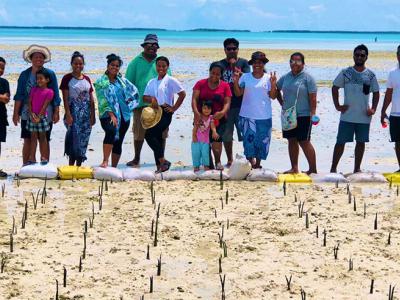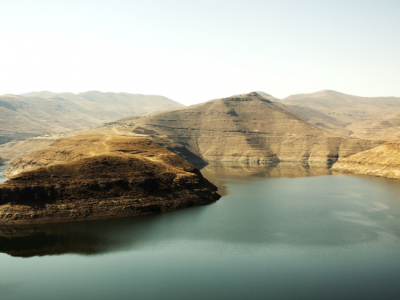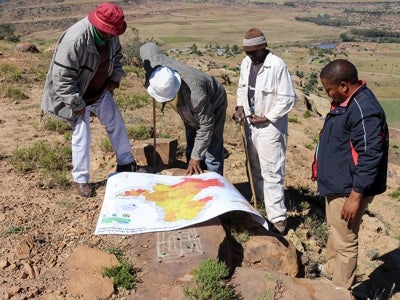
Ibis_B_0_5.jpg
The Southern Bald Ibis (Geronticus calvus), a bird species endemic to Lesotho, the eastern parts of South Africa and the western parts of Swaziland, has been vanishing. Classified as “vulnerable” in the IUCN Red Data Book, the birds have been threatened by habitat loss, human interference at breeding colonies; and in Lesotho in particular, by the use of Bald Ibis parts for traditional medicinal and ceremonial purposes.

IBIS%201.jpg
In Lesotho, the Ibis is known to roost and nest on the Thaba-Khubelu and Ha-Sechele cliffs in Tlokoeng Valley. An annual survey, conducted by the NGO Environmental and Sustainability Education Network of Lesotho (ESENEL) and the local communities, counted a maximum of 29 birds and 6 – 10 active nests each year on one cliff and only one breeding pair on the other. With the support of GEF SGP Lesotho, ESENEL implemented a project to conserve the Southern Bald Ibis by reducing threats to bird populations, educating the local community and developing eco-tourism activities. The project also aimed at relieving anthropogenic pressure on the wetlands, which were subject to unsustainable uses. The two-year project was supported by SGP Lesotho with a grant of USD $47,946 in GEF funding and leveraged USD $59,020 in co-financing from ESENEL and the local community.
A particular focus of project was the involvement of youth, especially that of herd-boys whose activities were deemed to contribute to the degradation of the Ibis population. In Lesotho, the young boys fulfill their cultural obligation by tending livestock in the mountains, an activity which can last for months or years and forces them to live in harsh and isolated conditions. During this time, herd-boys tend to rely on rodents and birds, including Ibis chicks, to supplement their spare nutrition. Herd-boys also exert pressure on local wetlands by having their livestock graze in those areas. Recognizing herd-boys as a special, vulnerable group and a key driver in securing Ibis conservation, the project sought to engage them.

IBIS%202.jpg
Among ESENEL’s outreach and awareness activities that specifically targeted herd-boys and other male youth. Herd-boys learned about the ecological impacts of their actions and were encouraged to eat resilient species of birds and abstain from having their livestock graze in already degraded wetlands. With a strong focus on youth empowerment, the project engaged several youth groups. For example, unemployed youth became involved in conducting the project’s scientific surveys under the supervision of an ornithologist. Another 20 youth were trained as tour guides for the valley’s newly-established environmental and educational trails. These youth have already guided community members on the trails, especially herd-boys and children who are fascinated by looking at birds through a telescope. As a result, the interest in bird watching was simultaneously intensified with the awareness on the importance of protecting them, particularly of the Southern Bald Ibis.
Through ESENL’s outreach campaign, adults also learned about the potential value of the Bald Ibis and other rare birds such as owls, the historic sites and the scenic landscape of Tlokoeng valley for eco-tourism. In turn, the communities decided to develop conservation and ecotourism strategies which were at an advanced state at the time of the project completion phase. To date, a 500m trail connecting camping and viewing sites has been constructed, bird-viewing equipment such as a telescope and binoculars has been acquired, and facilitators have been trained. Efforts to mobilize more resources to further develop the constructed trails and to refurbish the donated rondavels (African-Style huts) for accommodation and lecturing facilities are continuing.

IBIS%203.jpg
The eco-tourism and conservation initiatives are led by the newly-established local committee and village association, Thaba-Khubelu Conservation and Tours Association, which also includes three primary and four secondary schools. Eco-tourism is expected to attract about 250 local and international tourists each month, including students from neighboring schools. This will directly benefit the 50 members of the Thaba-Khubelu Conservation and Tours Association, as well as another 500 community members who can offer other services such as horse-back riding, accommodation, traditional food, and handicrafts.
Since the communities have come to appreciate the value of Ibises, there have been no more attempts to kill the birds for consumption or for medicinal purposes, and the breeding sites have experienced fewer disturbances by herd-boys or other youth. There is also growing awareness in the community about the importance of conserving wetlands, especially among the inhabitants who live close to the wetlands. However, education campaigns will need to extend beyond the valley area, since there is open access to the wetlands by villagers living in distant villages.

IBIS%204.jpg
The project is one of the very few bird protection initiatives implemented in the country. It has positively contributed to the implementation of Lesotho’s National Biodiversity Strategy and Action Plan, specifically to the following priority areas of action: (i) Conserve the diversity of landscapes, ecosystems, habitats, populations, species and genes in Lesotho, (ii) Attain sustainable use of Lesotho’s biological resources and minimize adverse impacts, (iii) Expand Lesotho’s capacity to conserve and manage biodiversity, and (iv) Create conditions and incentives for biodiversity conservation and sustainable use.
Background for editors
About the GEF
The GEF unites 183 countries in partnership with international institutions, civil society organizations (CSOs), and the private sector to address global environmental issues while supporting national sustainable development initiatives. Today the GEF is the largest public funder of projects to improve the global environment. An independently operating financial organization, the GEF provides grants for projects related to biodiversity, climate change, international waters, land degradation, the ozone layer, and persistent organic pollutants.
Since 1991, GEF has achieved a strong track record with developing countries and countries with economies in transition, providing $11.5 billion in grants and leveraging $57 billion in co-financing for over 3,215 projects in over 165 countries. For more information, visit www.thegef.org.
About the GEF Small Grants Programme
Launched in 1992, GEF SGP supports activities of nongovernmental and community-based organizations in developing countries towards climate change abatement, conservation of biodiversity, protection of international waters, reduction of the impact of persistent organic pollutants and prevention of land degradation while generating sustainable livelihoods.
Since its creation, GEF SGP has provided over 18,500 grants to communities in over 126 developing countries. Funded by the Global Environment Facility (GEF) as a corporate programme, GEF SGP is implemented by the United Nations Development Programme (UNDP) on behalf of the GEF partnership, and is executed by the United Nations Office for Project Services (UNOPS).
Media contacts:
Katharina Davis, Knowledge Management and Communications Consultant, GEF Small Grants Programme, katharina.davis@undp.org, +1 (646) 781-4386 www.sgp.undp.org
Christian Hofer, Senior Communication Officer, GEF, chofer@TheGEF.org, +1 (202) 458-0938 www.TheGEF.org


